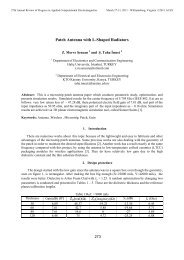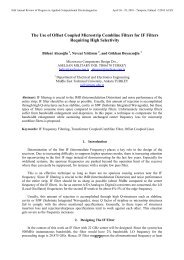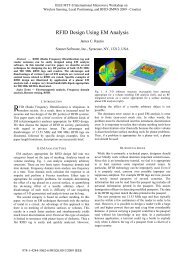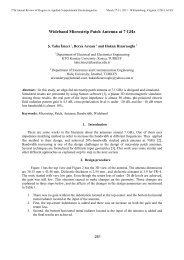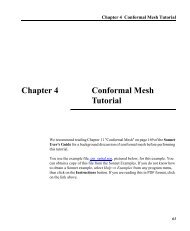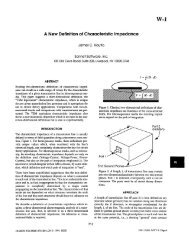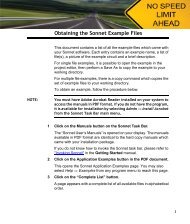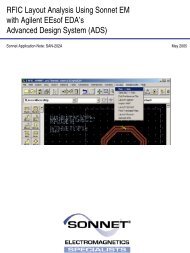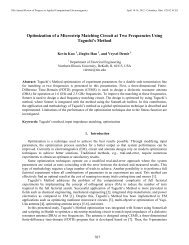Electromagnetic Analysis Speeds RFID Design - Sonnet Software
Electromagnetic Analysis Speeds RFID Design - Sonnet Software
Electromagnetic Analysis Speeds RFID Design - Sonnet Software
- No tags were found...
You also want an ePaper? Increase the reach of your titles
YUMPU automatically turns print PDFs into web optimized ePapers that Google loves.
frequency, but, for this case, that is no problem. The result using this port is almost the same asbefore.Special metal types are added by using “Circuit->Metal Types->Add”. The capacitor is a“General” metal type with all values equal to zero except for XDC. Since there is no longer anytransmission line to remove, and the port discontinuity is very small, we can turn de-embeddingoff (<strong>Analysis</strong>->Setup->Advanced->uncheck de-embed).How does coupling vary with the offset between the reader coil and the tag coil? To check this[6], we added a second inductor 50 mm above the first one, Figure 8. We also made the boxcontaining the circuit bigger. This is important because we do not want the inductor to get tooclose to the sidewalls.For the analysis, we varied the offset from 0 mm to 160 mm in steps of 40 mm. The readerinductor is shown above with an offset of 40 mm. <strong>Sonnet</strong> is set up to automatically calculate afull frequency sweep for each of the five reader coil positions. Each frequency sweep generatesabout 300 data points. Because the <strong>Sonnet</strong> ABS interpolation is used, analysis at only fourfrequencies is needed to generate data at all 300 frequencies.After completing the <strong>Sonnet</strong> analysis, we can determine how much voltage is generated at the tagcoil (port 1) when we put current into the reader coil (port 2). This is just the value of Z 12 . Forexample, if Z 12 is 9000 Ohms, then 1 mA into the reader coil generates 9 volts on the tag coil port.Since the <strong>Sonnet</strong> layout includes the internal resistance of the <strong>RFID</strong> IC, a full 9 volts will appearat the <strong>RFID</strong> IC to be used for operation.Figure 9 shows that for both 0 mm offset and for 40 mm offset, the value of Z 12 is just under 9000Ohms. Thus, the <strong>RFID</strong> IC will have just under 9 Volts to operate for every 1 mA of current goinginto the reader coil.The value of Z 12 drops off quickly for 80 mm or more offset. At this location, the reader coil hasjust passed beyond the edge of the tag coil. For large offsets, the tag coil gets only about 2 Voltsfor every 1 mA flowing into the reader coil.When the tag coil gets enough power, it operates by repeatedly tuning and de-tuning the coil toresonance at 13.56 MHz, Figure 10 (from [7]). When the tag resonant circuit is de-tuned, the tagcoil has no effect on the impedance of the reader coil. When the tag coil is resonant, it couplesstrongly to the reader coil and changes the reader coil impedance. It is this change in impedancethat is read by the reader.When the tag coil is resonant, the input impedance of the reader coil is Z 22 . When the tag coil isde-tuned, the tag coil has no effect on the reader coil. In this case, the reader coil impedance isthe same as if there is no tag coil there at all. In Figure 11, we see this difference directly. Bysensing this change in coil impedance, the reader can read the information sent by the tag coil.When there is a large offset between the reader coil and tag coil, the tag coil has no effect on thereader coil. The reader coil has an input impedance of about 18000 Ohms. When the tag coil is



